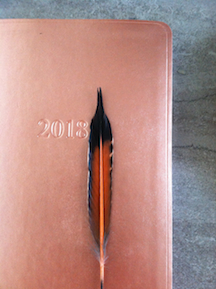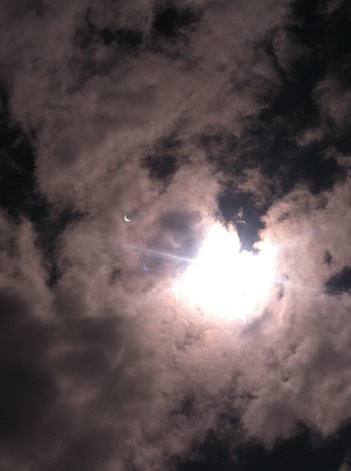Feather
 Thursday, April 5, 2018 at 01:10PM
Thursday, April 5, 2018 at 01:10PM  Feather: Colaptes Aurastus
Feather: Colaptes Aurastus
"ATTENTION," A VOICE BEGAN TO CALL, AND IT WAS AS THOUGH an oboe had suddenly become articulate. "Attention," it repeated in the same high, nasal monotone. "Attention."
-Aldous Huxley, Island
I lost my keys. The car key, house keys, mailbox key, all on a clear plastic stretchy- cord that had been hanging from my wrist like a clunky bracelet. I was walking in the woods with my puppy, Belle, when I noticed the all important keys were missing. Just when we had started our walk, I heard a woodpecker, tap tap tapping on a tree. Later, I thought I heard the same distinct sound above my head when I noted with a shock, that the keys were no longer around my wrist.
A terrible sinking feeling passed through me as I realized we had been walking a long time, two hours perhaps, and I had no idea where I dropped them. Everywhere underfoot, crunchy dry leaves and dusty earthen paths, much the same coloration as the gold and silver-toned metal keys. It seemed impossible to find them. I thought, "maybe I dropped them when I took off my sweater and tied it around my waist, but where was that?” Talking to myself, "just maybe if I go back and retrace my steps, I will find them." Each step back seems to bring up more dread, impatience and fear. "How will I get out of this mess?" Cell phone locked in vehicle. Feet hot and tired. Thirsty. I become increasingly agitated, but a small clear voice of intuition tells me twice to go back toward the sound of the woodpecker.
This is a story in two parts and I am telling it a little out of sequence. The day prior, I met a young man visiting New Mexico on a spiritual quest. He was spending a night at the end of his trip with my friend who co-parents Belle, our shared puppy. Belle lives with my friend full time and I get to visit her each afternoon. That day Belle and I went for a walk just after meeting this young man, Kyle, to a place along a clear ditch. When we came to my favorite spot, I looked down and there was a beautiful feather, a flicker feather, at my feet. Colaptes Aurastus is named for the brilliant flash of coloring under it's wings and tail feathers. I made earrings from their magical feathers a couple years ago and then immediately lost one, so I was grateful to find this one, so similar, a near match, to the feather that flew off my ear. Tears welled up in my eyes when I saw it bright on the ground. I picked it up and turned it over and then carefully put it into the breast pocket of my coat, where it would be protected while we walked.
Flickers live across America, yellow shafted in the north and east and bright orange/red in the southwest. Common along the river and ditches here, this winter I watched one perched on a branch at a close vantage point. They have a bib of dark feathers, like a necklace, just below the throat and a breast almost polka-dotted with black and white feathers, a dashing red brushstroke under their black round eye. Very handsome birds.
I feel certain that all of life is consciousness and that we only have to recognize that mysterious wonder, to be open to receive. Communication is happening between all aspects of nature-humans, animals, plants-all the time. The more I connect on this level of unity, the more I find it to be true.
When we returned that afternoon to my friend's property, Kyle was resting in a hammock, reading a book by Aldous Huxley, Island. There is an awesome illustration of a bird on the cover of the book, but I didn't catch that synchronicity at first. We chatted a bit and I shared that I have been working on a series of paintings for several years of specific birds, bird wings and bird feathers. He said, "Oh, let me show you a feather I found ..." Somehow, I knew in that moment, that he was about to show me a flicker feather. Indeed, he pulled out the same exact species feather from between the pages of Huxley’s final book, a story coincidently, about a place of utopia.
His feather was the same length, with the same striking black and orange pattern as the one I had just found. I showed him my feather and we compared them. Both were black on one side, except for the shaft and orange on the other with a thin quill, a shock of orange almost neon, running through the center. His was a right wing feather and mine, a pointed tail feather.
The next day, when I lost my keys, it was the same type of woodpecker, the northern flicker, who called to my attention with it's drumming-like sound. "Go to the area where you noticed the keys missing from your wrist..." So I turned around for the second time, unsure and feet dragging, calling Belle along, we walked to the area where we originally entered and where I first heard the woodpecker drumming. With very little effort, I found the keys laying in dry leaves, near a crumbled old can, I had noticed earlier. The current keys to opening my all important doors, were in hand. It would be an understatement to say, all my anxiety lifted at the sight of them.
The keys in the leaves had the look of something real, for sure, very real, indispensable to getting into my vehicle, that I very much identified with as more than metaphor. Witnessing the interconnectedness of everything was further underlined for me, with the momentary taste of utopia, when everything worked out perfectly. As I consider all of this now, I am aware of “key” as something else, having to do with the way, the path, as in the key to the mystery. Or “key” meaning someone pivotal, as in an individual of significance. I am turning the key, turning around these metaphors in my mind as a way to appreciate, to deepen this experience on even more levels. I imagine it will be with me for a long time to come, I can’t resist saying, this opens new doors of perception.
